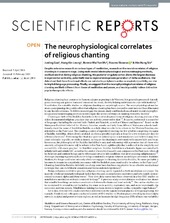| dc.contributor.author | Gao, Junling | |
| dc.contributor.author | Leung, Hang Kin | |
| dc.contributor.author | Wu, Bonnie Wai Yan | |
| dc.contributor.author | Skouras, Stavros | |
| dc.contributor.author | Sik, Hin Hung | |
| dc.date.accessioned | 2020-05-08T13:49:09Z | |
| dc.date.available | 2020-05-08T13:49:09Z | |
| dc.date.issued | 2019-03-12 | |
| dc.Published | Gao, Leung, Wu, Skouras S, Sik. The neurophysiological correlates of religious chanting. Scientific Reports. 2019;9:4262 | eng |
| dc.identifier.issn | 2045-2322 | |
| dc.identifier.uri | https://hdl.handle.net/1956/22156 | |
| dc.description.abstract | Despite extensive research on various types of meditation, research on the neural correlates of religious chanting is in a nascent stage. Using multi-modal electrophysiological and neuroimaging methods, we illustrate that during religious chanting, the posterior cingulate cortex shows the largest decrease in eigenvector centrality, potentially due to regional endogenous generation of delta oscillations. Our data show that these functional effects are not due to peripheral cardiac or respiratory activity, nor due to implicit language processing. Finally, we suggest that the neurophysiological correlates of religious chanting are likely different from those of meditation and prayer, and would possibly induce distinctive psychotherapeutic effects. | en_US |
| dc.language.iso | eng | eng |
| dc.publisher | Nature Research | eng |
| dc.rights | Attribution CC BY | eng |
| dc.rights.uri | http://creativecommons.org/licenses/by/4.0/ | eng |
| dc.title | The neurophysiological correlates of religious chanting | eng |
| dc.type | Peer reviewed | |
| dc.type | Journal article | |
| dc.date.updated | 2020-02-14T10:29:40Z | |
| dc.description.version | publishedVersion | |
| dc.rights.holder | Copyright 2019 The Author(s) | eng |
| dc.identifier.doi | https://doi.org/10.1038/s41598-019-40200-w | |
| dc.identifier.cristin | 1754839 | |
| dc.source.journal | Scientific Reports | |

